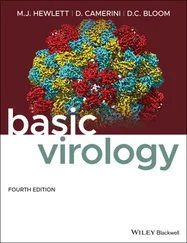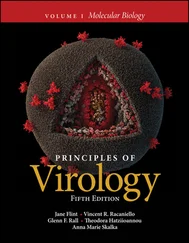Jane Flint - Principles of Virology
Здесь есть возможность читать онлайн «Jane Flint - Principles of Virology» — ознакомительный отрывок электронной книги совершенно бесплатно, а после прочтения отрывка купить полную версию. В некоторых случаях можно слушать аудио, скачать через торрент в формате fb2 и присутствует краткое содержание. Жанр: unrecognised, на английском языке. Описание произведения, (предисловие) а так же отзывы посетителей доступны на портале библиотеки ЛибКат.
- Название:Principles of Virology
- Автор:
- Жанр:
- Год:неизвестен
- ISBN:нет данных
- Рейтинг книги:3 / 5. Голосов: 1
-
Избранное:Добавить в избранное
- Отзывы:
-
Ваша оценка:
- 60
- 1
- 2
- 3
- 4
- 5
Principles of Virology: краткое содержание, описание и аннотация
Предлагаем к чтению аннотацию, описание, краткое содержание или предисловие (зависит от того, что написал сам автор книги «Principles of Virology»). Если вы не нашли необходимую информацию о книге — напишите в комментариях, мы постараемся отыскать её.
Volume I: Molecular Biology
Volume II: Pathogenesis and Control
Principles of Virology, Fifth Edition
Principles of Virology — читать онлайн ознакомительный отрывок
Ниже представлен текст книги, разбитый по страницам. Система сохранения места последней прочитанной страницы, позволяет с удобством читать онлайн бесплатно книгу «Principles of Virology», без необходимости каждый раз заново искать на чём Вы остановились. Поставьте закладку, и сможете в любой момент перейти на страницу, на которой закончили чтение.
Интервал:
Закладка:
What Do Viral Genomes Look Like?
Some small RNA and DNA genomes enter cells from virus particles as naked molecules of nucleic acid, whereas others are always associated with specialized nucleic acid-binding proteins or enzymes. A fundamental difference between the genomes of viruses and those of their hosts is that although viral genomes are often covered with proteins, they are usually not bound by histones in the virus particle (polyomaviral and papillomaviral genomes are exceptions). However, it is likely that all viral DNAs become coated with histones shortly after they enter the nucleus.
While viral genomes are all nucleic acids, they should notbe thought of as one-dimensional structures. Virology textbooks (this one included) often draw genomes as straight, one-dimensional lines, but this notation is for illustrative purposes only; physical reality is certain to be dramatically different. Genomes have the potential to adopt amazing secondary and tertiary structures in which nucleotides may engage in long-distance interactions ( Fig. 3.9).
The sequences and structures near the ends of viral genomes are often indispensable for replication. For example, the DNA sequences at the ends of parvovirus genomes form T-shaped structures that are required for priming during DNA synthesis. Proteins covalently attached to 5′ ends, inverted and tandem repeats, and bound tRNAs may also participate in the replication of RNA and DNA genomes. Secondary RNA structures may facilitate translation (the internal ribosome entry site [IRES] of picornavirus genomes) and genome packaging (the structured packaging signal of retroviral genomes, [ Fig. 3.9]).
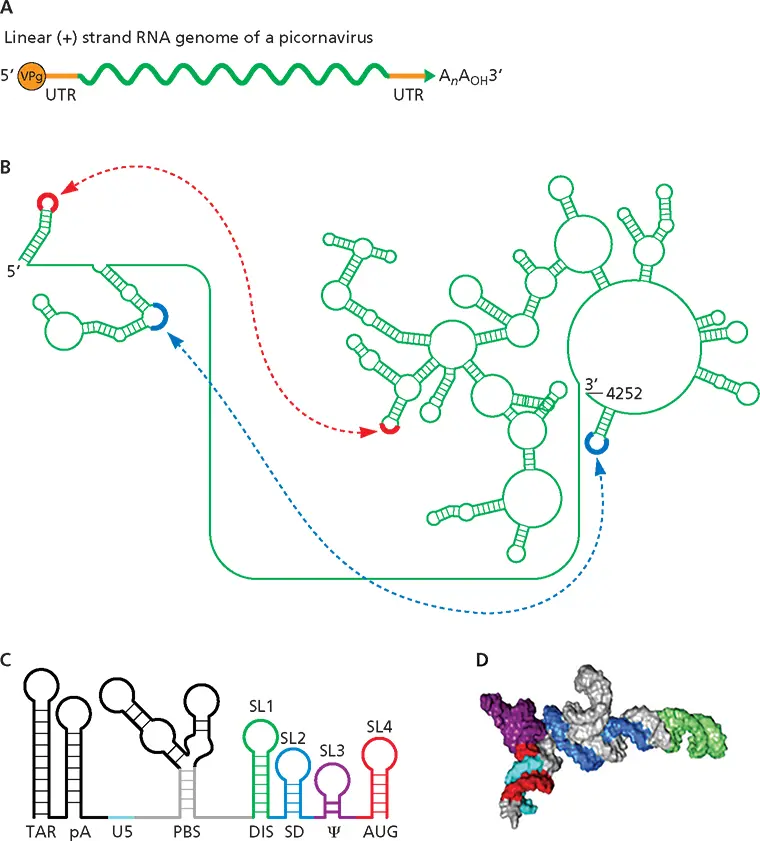
Figure 3.9 Genome structures in cartoons and in real life. (A)Linear representation of a picornavirus RNA genome. UTR, untranslated region. (B)Long-distance RNA-RNA interactions in a tombusvirus RNA genome. The 4,252-nucleotide viral genome is shown with secondary RNA structures at the 5′ and 3′ ends. Sequences that base-pair are shown in blue (required for RNA frameshifting) and red (required to bring ribosomes from the 3′ end to the 5′ end). Courtesy of Anne Simon, University of Maryland. (C)Schematic representation of RNA secondary-structure elements in the human immunodeficiency virus type 1 5′ leader, including the core packaging signal. (D)NMR structure of the RNA shown in C, without elements colored black. Courtesy of Paul Bieniasz, Rockefeller University.
Coding Strategies
The compact genome of most viruses renders the “one gene, one mRNA” dogma inaccurate. Extraordinary tactics for information retrieval, such as the production of multiple subgenomic mRNAs, alternative mRNA splicing, RNA editing, and nested transcription units ( Fig. 3.10), allow the production of multiple proteins from a single viral genome. Further expansion of the coding capacity of the viral genome is achieved by posttranscriptional mechanisms, such as polyprotein synthesis, leaky scanning, suppression of termination, and ribosomal frameshifting. In general, the smaller the genome, the greater the compression of genetic information.
What Can Viral Sequences Tell Us?
Knowledge about the physical nature of genomes and coding strategies was first obtained by the study of the nucleic acids of viruses. Indeed, DNA sequencing technology was perfected on viral genomes. The first genome of any kind to be sequenced was that of the Escherichia coli bacteriophage MS2, a linear ssRNA of 3,569 nucleotides. dsDNA genomes of larger viruses, such as herpesviruses and poxviruses (vaccinia virus), were sequenced completely by the 1990s. Since then, high-throughput sequencing has revolutionized the biological sciences, allowing rapid determination of genome sequences from clinical and environmental samples. Organand tissue-specific viromes of many organisms have been determined. In one study, over 186 host species representing the phylogenetic diversity of vertebrates, including lancelets (chordates, but considered invertebrates), jawless fish, cartilaginous fish, ray-finned fish, amphibians, and reptiles, all ancestral to birds and mammals, were sampled. RNA was extracted from multiple organs and subjected to high-throughput sequencing. Among 806 billion bases that were read, 214 new viral genomes were identified. The results show that in vertebrates other than birds and mammals, RNA viruses are more numerous and diverse than suspected. Every viral family or genus of bird and mammal viruses is also represented in viruses of amphibians, reptiles, or fish. Arenaviruses, filoviruses, and hantaviruses were found for the first time in aquatic vertebrates. The genomes of some fish viruses have now expanded so that their phylogenetic diversity is larger than in mammalian viruses. New relatives of influenza viruses were found in hagfish, amphibians, and ray-finned fish. As of this writing, the complete sequences of >8,000 different viral genomes have been determined. Published viral genome sequences can be found at http://www.ncbi.nlm.nih.gov/genome/viruses/.
| Mechanism | Diagram | Virus | Chapter(s) | Figures in appendix |
|---|---|---|---|---|
| MultiplesubgenomicmRNAs |  |
Adenoviridae Hepadnaviridae Herpesviridae Paramyxoviridae Poxviridae Rhabdoviridae | 7, 87, 107676 | 1, 211, 1217, 1825, 2631, 32 |
| Alternative mRNA splicing |  |
Adenoviridae Orthomyxoviridae Papillomaviridae Polyomaviridae Retroviridae | 7, 887, 8810 | 1, 215, 1623, 2429, 30 |
| RNA editing | 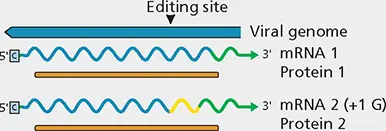 |
Paramyxoviridae Filoviridae Hepatitis delta virus | 6, 888 | |
| Information on both strands |  |
Adenoviridae Polyomaviridae Retroviridae | 7-97-910 | 1, 223, 2429, 30 |
| Polyproteinsynthesis | 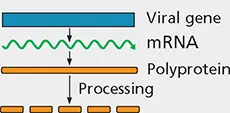 |
Alphaviruses Flaviviridae Picornaviridae Retroviridae | 6, 116, 116, 116, 11 | 33, 349, 1021, 2229, 30 |
| Leaky scanning | 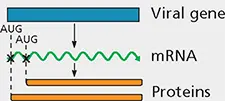 |
Orthomyxoviridae Paramyxoviridae Polyomaviridae Retroviridae | 11111111 | 15, 1629, 30 |
| Reinitiation |  |
Orthomyxoviridae Herpesviridae | 1111 | 15, 16 |
| Suppression of termination |  |
Alphaviruses Retroviridae | 1111 | 33, 3429, 30 |
| Ribosomalframeshifting |  |
Astroviridae Coronaviridae Retroviridae | 111111 | 5, 629, 30 |
| IRES |  |
Flaviviridae Picornaviridae | 1111 | 21, 22 |
| Nested mRNAs | 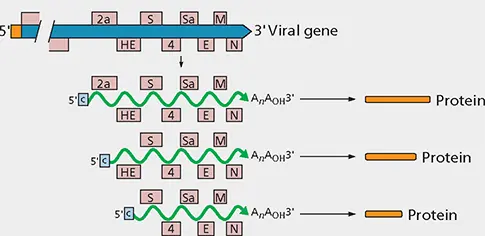 |
Coronaviridae Arteriviridae | 66 | 5, 65, 6 |
Figure 3.10 Information retrieval from viral genomes. Different strategies for decoding the information in viral genomes are depicted. CBF, CCAAT-binding factor; USF, upstream stimulatory factor; IRES, internal ribosome entry site.
Читать дальшеИнтервал:
Закладка:
Похожие книги на «Principles of Virology»
Представляем Вашему вниманию похожие книги на «Principles of Virology» списком для выбора. Мы отобрали схожую по названию и смыслу литературу в надежде предоставить читателям больше вариантов отыскать новые, интересные, ещё непрочитанные произведения.
Обсуждение, отзывы о книге «Principles of Virology» и просто собственные мнения читателей. Оставьте ваши комментарии, напишите, что Вы думаете о произведении, его смысле или главных героях. Укажите что конкретно понравилось, а что нет, и почему Вы так считаете.





